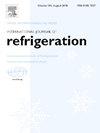Experimental compressed liquid density measurements and correlation of the binary mixture {3,3,3-trifuoropropene (R1243zf) + isobutane (R600a)}
IF 3.5
2区 工程技术
Q1 ENGINEERING, MECHANICAL
International Journal of Refrigeration-revue Internationale Du Froid
Pub Date : 2025-01-21
DOI:10.1016/j.ijrefrig.2025.01.013
引用次数: 0
Abstract
In the context of evolving regulations such as the F-gas Regulation and the Kigali Amendment to the Montreal Protocol, the exploration of alternatives to fluorinated greenhouse gases in air conditioning and refrigeration has garnered significant attention. Essential attributes sought in viable refrigerants encompass low Global Warming Potential (GWP), thermodynamic cycle efficiency, non-flammability, non-toxicity, material compatibility, and cost-effectiveness. Hydrofluoroolefins (HFOs) have emerged as promising replacements for hydrofluorocarbons (HFCs) and hydrochlorofluorocarbons (HCFCs) in HVAC and refrigeration systems. Simultaneously, the quest for low GWP refrigerants has prompted a revaluation of hydrocarbons (HCs) like propane (R290) and isobutane (R600a), renowned for their efficiency, minimal charge requirements, and affordability despite their flammability. While extensive data and reliable Equations of State (EoS) are available for HCs, HFOs lack comprehensive information. This study contributes empirical measurements on the compressed liquid density of the 3,3,3-trifluoropropene (R1243zf) + isobutane (R600a) binary system. Utilizing a vibrating tube densimeter, measurements were conducted on three mixture compositions within the temperature range of 283.15 K to 353.15 K and at pressures ranging from near saturation to 35 MPa. The obtained dataset, combined with existing literature, served as the basis for a new mixture model developed using the Helmholtz-energy-explicit EoS. This model accurately represents the behaviour of the binary mixture, enhancing the available understanding of its thermodynamic properties.
求助全文
约1分钟内获得全文
求助全文
来源期刊
CiteScore
7.30
自引率
12.80%
发文量
363
审稿时长
3.7 months
期刊介绍:
The International Journal of Refrigeration is published for the International Institute of Refrigeration (IIR) by Elsevier. It is essential reading for all those wishing to keep abreast of research and industrial news in refrigeration, air conditioning and associated fields. This is particularly important in these times of rapid introduction of alternative refrigerants and the emergence of new technology. The journal has published special issues on alternative refrigerants and novel topics in the field of boiling, condensation, heat pumps, food refrigeration, carbon dioxide, ammonia, hydrocarbons, magnetic refrigeration at room temperature, sorptive cooling, phase change materials and slurries, ejector technology, compressors, and solar cooling.
As well as original research papers the International Journal of Refrigeration also includes review articles, papers presented at IIR conferences, short reports and letters describing preliminary results and experimental details, and letters to the Editor on recent areas of discussion and controversy. Other features include forthcoming events, conference reports and book reviews.
Papers are published in either English or French with the IIR news section in both languages.

 求助内容:
求助内容: 应助结果提醒方式:
应助结果提醒方式:


